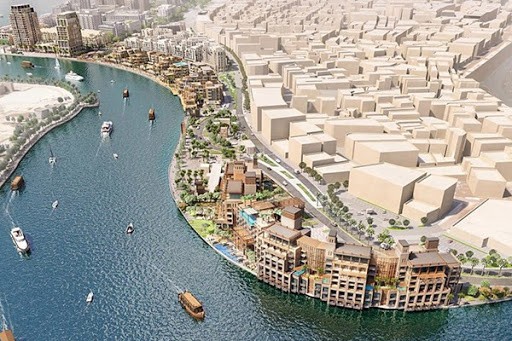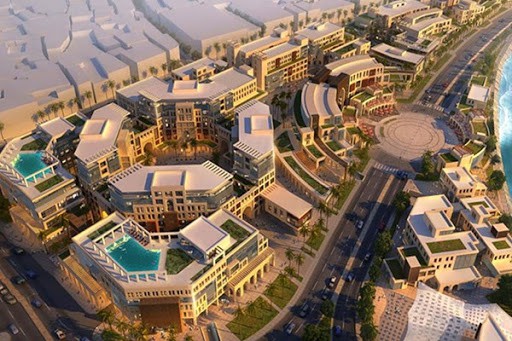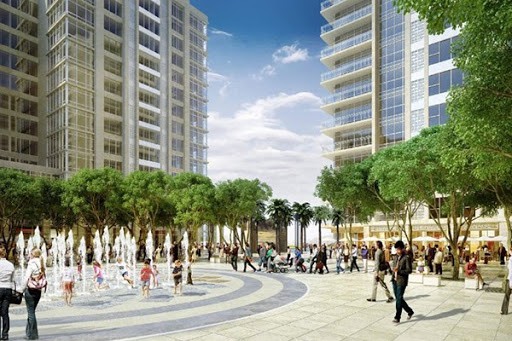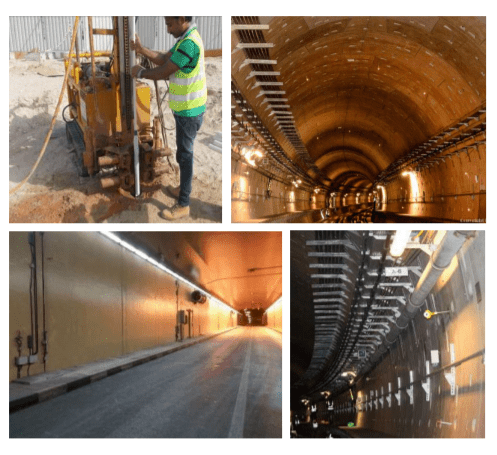The Deira Waterfront Development is strategically placed in the northern area of the Deira District, right across the street where the old Souqs and the Dubai Creek is located. It is planned to ensure the natural growth of the city, driving economic success and vitality of the area. Regenerating one of the oldest communities of the city will not only preserve the unique cultural values but will be extremely crucial for the city’s economic success.

The Deira Waterfront Development Project is in close proximity to the central destination and aims to have several fun components like leisure facilities, parks, and plazas, bicycle routes, transportation hubs along with retail facilities. It also involves the construction of several new plazas, mixed-use buildings, and green open spaces.
Apart from the new construction, the existing shops, commercial zones, parking, hotels, etc will also be improved to blend with the description of mixed-use development. The intention is to have a unique and beautiful seafront.
The Waterfront Project allows the Diera community to creatively and intelligently to blend the past, present, and future while preserving the heritage and culture.
Deira Waterfront Development – Plot 13
Phase 1 of the Deira Waterfront Project involved the development of 30 plots along the waterfront, with each having its own set of developments and designs.

One such plot, Plot-13 is situated in the north area of Dubai in the Deira District. The Mixed Development at Plot 13 involved the construction of a two-level basement (approximately 10 m deep excavation) between the Al Shindagha tunnel and the Dubai Metro Green Line tunnel.
The shoring work was in close vicinity to both the tunnels, with the nearest edge only 10m from the Green Line Tunnel and 15m from the existing Al Shindagha Road tunnel. The involvement of heavy construction activities so near the tunnels made it crucial and necessary to monitor the areas.
Let’s take a look at the proposed monitoring solution by Encardio Rite, followed by the instrumentation of the site.
| Read More: Emerging Technologies in Tunnel Instrumentation and Monitoring |
Monitoring Solution – Deira Waterfront Development
With a considerable risk involved due to the existing tunnels, the main intention of the instrumentation and monitoring procedure was to systematically recognize any design risks caused by the construction. For complete safety, it was crucial to monitor the response of ground, groundwater, and viaduct foundations during the construction period.
The Turnkey Services Included:
- Supply and Installation of Geotechnical and Geodetic Instruments
- Manual and Automatic Surveying
- Online Monitoring of crucial parameters and areas
- Manual Monitoring of Installed Geotechnical Instruments
- Daily & weekly reporting with evaluation & interpretations
- Pre-construction condition monitoring of both tunnels

Instrumentation – Deira Waterfront Development
Encardio Rite provided instrumentation and monitoring services for the ongoing excavation work as well as for the existing metro and road runnels.
Let’s take a look at the geotechnical sensors and instruments used during the process.
Instrumentation during Excavation and Ground Monitoring
- Inclinometer The Inclinometer was employed to monitor the lateral movement and movement of soil between the construction area and the tunnel.
- In-place Inclinometer In-place Inclinometers were used to observe the lateral movement along with the deformation of earthworks and shoring walls.
- Standpipe Piezometer The Piezometer was involved in the monitoring of water level/drawdown during the construction period.
- Ground Settlement Point They were used to monitor soil settlement and deformation of the ground surface.
- Anchor Load Cell Load Cells were utilized for the monitoring of force in the ground anchor.
| Read More: [Case Study] Bogibeel Bridge: Asia’s Second Longest Rail-Road Bridge |

Instrumentation and monitoring of the Existing Metro, Road Tunnels, and Rail Tracks
- Strain Gage They were used to monitor the stress in tunnels and also to alter the in-strain of tunnel lining. This was done to hoop compression and bending moments.
- Tape Extensometer These were employed in the Shindagha tunnel to monitor convergence.
- Borehole Extensometer The Automatic Extensometer was designed and installed to monitor the deformation of the existing line.
- Magnetic Extensometer These were involved in the monitoring of subsurface settlement.
- Beam Sensor/Tiltmeter These sensors were employed for monitoring differential movement and tilting in tunnels, and the variation in diameter under unbalanced loading.
- Beam Sensor Beam Sensors were used to keep an eye on the movement of the trackbed.
- Tri-axial Vibration Sensor They were involved in the monitoring of the impact of piling operations on the tunnel.
- Prism Target Prism Target was installed for the monitoring of displacement in the tunnel.
- Crack Meter To monitor changes in the width of existing cracks & joints within the tunnel
The sensor installation in the existing metro tunnel was a crucial and time-constrained task as the metro trains only allowed 2 hours at midnight for the installation. For critical geotechnical sensors, online monitoring was carried on with the help of our range of advanced automatic data loggers and data acquisition systems. For online monitoring of geodetic points, Automatic Total Stations (ATS) with complex control boxes were used.
The Monitored and Recorded Data was made available through our web-based Data Management System to the concerned parties, making it accessible through their desktops. Monitoring Reports were formulated and submitted for the geotechnical and geodetic monitoring data on a daily and weekly basis. Monitoring reports also included the interpretations of variations observed in instrument data concerning the construction progress in the respective area.
This brings us to the end of our Case Study on Deira Waterfront Development. Hope you found it interesting.
For more such articles, keep watching this space.